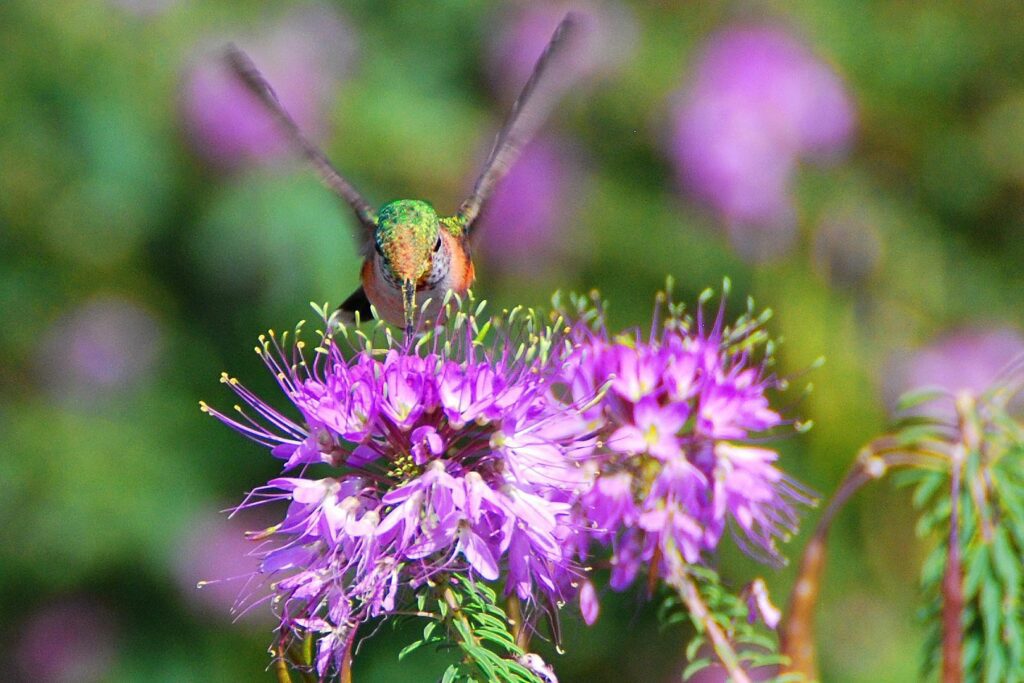
Hummingbird, Broad-Billed photo by ALAN SCHMIERER – Wikimedia commons
15 Fascinating Facts About Hummingbirds
Hummingbirds are unique birds known for their humming sound created by their beating wings, which flap at high frequencies audible to other birds and humans. These birds, famous for their vibrant colours and exquisite speed, have many characteristics that catch the eye. The hummingbird world is full of mind-blowing tales and secrets that make them so intriguing, from their fascinating behaviours to their unique physical characteristics. Hummingbirds are incredibly fast, tiny, and agile, making them an intriguing topic for both bird lovers and explorers.
Their movements captivate our attention, and their intricate patterns are breathtaking. These birds, known for their extraordinary behaviours and movements, exist on different wavelengths than ordinary birds.
Regardless of their size, hummingbirds’ adaptability and intelligence to a wide range of environments and conditions is a clear indication of how size does not determine an animal’s well-being, even though they are smaller than normal birds. With their various characteristics, these birds play an important role in various mythologies and cultures all over the world, adding to their mysticism and allure. Let us delve deeper to shed more light on the fascinating world of hummingbirds and inspire a greater appreciation of these incredible creatures.
1. Hummingbirds are the only birds that can fly backwards

Anna’s hummingbird photo by Robert McMorran – Wikimedia commons
The only birds that can fly backwards and fly upside down are hummingbirds. Depending on the species, its distinctive wing structure and quick wing beats enable this special skill. Hummingbirds can get nectar from blooms in all directions thanks to their ability to fly backwards, providing them with an advantage in their hunt for sustenance.
2. They are also the only birds that can hover in mid-air
Hummingbirds possess the ability to hover in mid-air thanks to their adaptive features. They can accomplish this due to their special physical modifications, like their wings and muscles.
Hummingbirds utilize their wings to spin an air current beneath their bodies to hover. The bird can remain still for a long time because the air cushion created by the vortex helps it balance.
3. Hummingbirds are incredibly fast and can fly up to 60 miles per hour

Hummingbird Trochilidae taken during quarantine in the city of Arequipa Peru photo by Tambo de Bronce – Wikimedia commons
Hummingbirds are exceptionally quick fliers and may fly at up to 60 mph while diving and doing high-speed manoeuvres. Because of their particular physical adaptations, including their wing structure, muscle strength, and flight skill, they can fly at these astounding speeds. Hummingbirds sustain their high-speed flying by using a special mechanism known as “flapping and gliding.”
Also Read: 15 Amazing Facts About Kangaroos
4. They consume up to twice their body weight in nectar and insects daily

Rufous Hummingbird on Rocky Mountain Beeplants photo by Great Sand Dunes National Park and Preserve – Wikimedia commons
Hummingbirds need a lot of energy to power their swift flight and active lifestyle due to their extremely high metabolism. Hummingbirds have evolved to devour up to double their body weight in nectar and insects each day to meet their energy needs.
As nectar feeders, hummingbirds are drawn to colourful, tubular-shaped flowers that are high in sugar. They take nectar from the blooms using their long, thin beaks and tongues, and because of their high metabolism, they can turn sugar into energy very quickly. Hummingbirds have a special digestive mechanism that enables them to metabolize sugary liquid very rapidly to consume such vast amounts of nectar.
5. They have excellent vision and can see ultraviolet light
Hummingbirds can detect flowers and nectar quite precisely thanks to their exceptional vision. By using their capacity to see in the ultraviolet spectrum, which is invisible to the human eye, they can identify patterns on flowers that direct them to the nectar source. Hummingbirds can distinguish between various flower species and select which ones offer the most nectar by using their capacity to perceive ultraviolet light. Hummingbirds can easily find food sources and maintain their high-intensity lifestyle because of their outstanding vision.
6. Hummingbirds lap up nectar at a rate of up to 13 licks per second

Ruby-throated hummingbird paul adams taking nectar photo sourced from Wikimedia commons
The specialized tongue of hummingbirds is uniquely equipped to rapidly ingest nectar. When extended, their lengthy, forked tongue can reach the length of their entire bill.
A hummingbird creates a little tube-like structure with its tongue that extends down into the flower while it consumes nectar. The hummingbird uses its tongue to capture up to 13 licks per second as it quickly licks the nectar into its mouth. The hummingbird’s tongue is designed with a series of grooves that assist guide the nectar up and into the bird’s mouth, enabling this quick feeding strategy. Small hairs on the tongue’s tip also aid in trapping nectar and keeping it there when the bird retracts its tongue.
7. The bee hummingbird weighs less than a penny
The bee hummingbird, which weighs only 2.6 grams, is the tiniest bird species in existence weighing only about 2.6 grams (0.09 ounces). This is less than a penny’s weight, which is approximately 2.5 grams (0.088 ounces). Hummingbirds can fly with amazing agility and precision thanks to their lightweight, lingering in one spot and darting between flowers fast to eat nectar.
8. Male hummingbirds perform elaborate courtship displays to attract mates

Rufous Humminbird, male, Randall Davis Audubon Center of Santa Fe photo by
Peter Wallack – Wikimedia commons
Hummingbird males engage in intricate courtship rituals to entice females. They employ a range of strategies, including equally complex pattern flying, flashing their vibrantly coloured feathers, and singing or vocal calls. The most effective displays can result in the male obtaining a female mate for reproduction. These displays help to demonstrate the male’s power and fitness.
9. Hummingbirds can remember every flower they have visited
Hummingbirds can recall every flower they have visited thanks to their exceptional memory. To recall the location of each flower, they use spatial memory in addition to visual clues like the colour and shape of the flower.
Hummingbirds can predict how long it will take for a flower to restock with nectar thanks to their keen sense of timing. They measure this by keeping track of how long it takes a flower to regenerate after it has been sucked from it. They can then visit the flowers that will yield the most nectar and maximize their foraging strategy.
Read More: 15 Fun Facts About Flowers
10. They have a unique figure-eight motion flying pattern

A male Ruby-throated Hummingbird in flight. photo by jeffreyw – Wikimedia commons
Hummingbirds can flap their wings in a figure-eight motion, which gives them a distinctive flying pattern. To hover and manoeuvre in confined places, they need to be able to produce lift and push on both the upstroke and downstroke of their wings. They can stay in the air and fly with incredible agility and precision thanks to their particular wing muscles, which allow them to flap their wings at a very astounding frequency.
11. Hummingbirds can live up to 12 years in the wild!
Hummingbirds seldom live up to 12 years in the wild because they are always at risk from predators, sickness, and competition for food. Although certain hummingbird species have been observed to live up to 12 years or more. A wild hummingbird’s life span normally ranges from three to five years, though this might change depending on the species and the environment.
12. They derive their name from the sound their wings make

Anna’s Hummingbird – Rear View photo by Noël Zia Lee – Wikimedia commons
The term “hummingbird” refers to a bird that makes a high-pitched humming or buzzing noise as a result of its rapid wing beats. The humming sound that hummingbirds make is caused by their wings beating so quickly, up to 80 times per second in certain species. Given the hummingbird’s small size and swift movements, which can make it challenging to see with the unaided eye, this sound is frequently one of the first signs that one is around. These birds have been referred to as “hummingbirds” at least since the 16th century.
13. Hummingbirds are known to migrate long distances
Some species of hummingbirds have been seen to travel up to 2,000 kilometres or more annually during their migration. For the winter, many hummingbirds from North America travel south to Mexico, Central America, or South America, where they can dependably obtain nectar and insects. A non-stop trip across the Gulf of Mexico by some species, like the Ruby-throated Hummingbird, can last up to 18–20 hours. Hummingbird migration routes and exact patterns can change based on the species and season.
14. Their hearts can beat up to 1,260 times per minute
Hummingbirds have the quickest heart rates of any bird species, beating up to 1,260 times per minute. Hummingbirds can sustain their fast metabolism and continual wing-flapping, which consumes a lot of energy, thanks to their quick heart rates. To put this into perspective, a hummingbird’s heart can beat over 10 times faster than the average human heart, which typically beats between 60 and 100 times per minute. Hummingbirds’ heart rates can also change based on their level of activity, with rates rising much higher during flying or courting displays.
15. Some hummingbirds enter a hibernation-like state to survive freezing temperatures

Male Stellula calliope Calliope Hummingbird photo by Cary Bass – Wikimedia commons
Some hummingbird species can go into a state of torpor, which is a brief drop in metabolic rate and body temperature that aids in energy conservation during times of scarcity of food or cold weather.
Hummingbirds can reduce their metabolic rate during torpor by up to 95%, allowing them to save energy and make do with scarce food supplies. Additionally, they may experience severe drops in body temperature, occasionally even below freezing. When the hummingbird wants to resume activity, it rapidly increases its internal temperatures and metabolic rate. This state of torpor can persist for several hours.
Related: 25 Interesting Facts about Birds
Planning a trip to Paris ? Get ready !
These are Amazon’s best-selling travel products that you may need for coming to Paris.
Bookstore
- The best travel book : Rick Steves – Paris 2023 – Learn more here
- Fodor’s Paris 2024 – Learn more here
Travel Gear
- Venture Pal Lightweight Backpack – Learn more here
- Samsonite Winfield 2 28″ Luggage – Learn more here
- Swig Savvy’s Stainless Steel Insulated Water Bottle – Learn more here
Check Amazon’s best-seller list for the most popular travel accessories. We sometimes read this list just to find out what new travel products people are buying.










